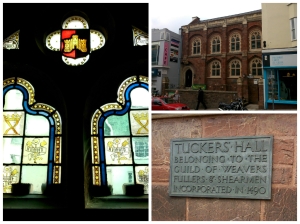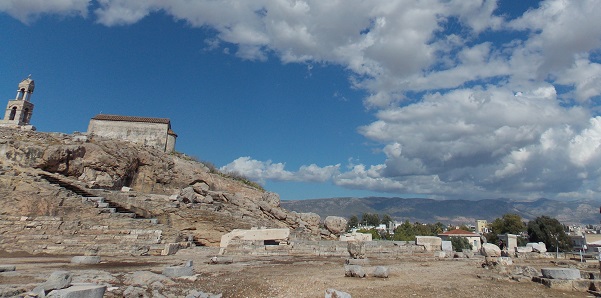: Carmen Talbot
Unexplored Exeter for Heritage Open Days 2014
The European Heritage Days (Journées européennes du patrimoine) initiative was created by the Council of Europe and the European Commission in 1991 in order to raise awareness and to promote the cultural wealth of Europe, with the key caveat that all events, open days, and talks must be free to attend. Now with 50 signatory states participating, the EHD have wider-reaching aims, including in 2014 to:
- raise the awareness of European citizens to the richness and cultural diversity of Europe;
- create a climate in which the appreciation of the rich mosaic of European cultures is stimulated;
- counter racism and xenophobia and encourage greater tolerance in Europe and beyond the national borders;
- inform the public and the political authorities about the need to protect cultural heritage against new threats;
- invite Europe to respond to the social, political and economic challenges it faces.
(Council of Europe and European Union 2014, http://pjp-eu.coe.int/en/web/ehd-jep/presentation)

Map of the city of Exeter from 1832. The Roman baths lie under the green in front of the Cathedral, rough in the centre between the letters R and L. Used under CC SA 3.0 license from Plymouth University
The English branch of the programme, called Heritage Open Days, celebrates its 20th anniversary this year, taking place between 11th and 14th September 2014. I visited several sites over the weekend portion of the open days in my home city of Exeter. Exeter is possibly most well-known as the site of a Roman legionary fortress and subsequent province, Isca Dumnoniorum. Built over the Roman civic centre (and at the heart of the modern city centre) is the large gothic Cathedral of St. Peter. It was a talk discussing this very site by the Devon Archaeological Society that was the first Heritage Open Days event I attended this year. This talk presented the (continuing) history of the Roman Baths of Exeter, excavated in 1972/3 and subsequently recovered with sand. The key issue with the site is that the mid-1st century AD Legionary baths lie under both the Cathedral Green, a 1970’s processional stairway listed by English Heritage, and adjacent buildings in the Cathedral Close. In order to expose the Roman Baths, at least part of the listed steps would have to destroyed, a WWII memorial rehomed, and a large portion of the landscaped Cathedral Green dug up. In the 40 years since excavation, various schemes have been put forward, yet so far none have seen fruition, with funding or feasibility being the main stumbling blocks. Last year the idea was reignited with the key stakeholder, the Diocese of Exeter, prepared to discuss the possibility of exposing the baths. The key issues (that have existed from when the site was excavated 40 years’ previously) continue to be the location and how the re-excavation and exposure would work architecturally, the funding for such a large project, and the site’s ongoing conservation (Allan 2014, 3). Such a large and historically interesting site and interpretation centre would bring many tourists, visitors and educational groups to the city, and this factor has been cited (with reference to the success of the Roman bath house at Bath) as one of the reasons to finally make the project a reality.
I also attended open days at sites not often (in one case not at all until now) open to the public. These included Tuckers Hall and the Dissenter’s Graveyard. The former is a guild hall built in the mid-1400s for weavers, tuckers and shearmen during the city’s booming wool trade. The building has managed to survive, tucked away on one of the main roads in the city centre and surviving for hundreds of years through the collapse of the wool trade in the city, infrastructural changes, renovation and even the extensive Luftwaffe bombing of the city during WWII. Now a Grade II* listed building, it is still owned and managed by the Incorporation of Weavers, Fullers and Shearmen, and open to the public on selected days. Upon entering the building, I immediately regretted not visiting sooner, as it has a great exhibition of the history of wool trading in Exeter, the wool making process and evidence of the ubiquity of wool working in the city prior to the industrial revolution. The recent development project that enabled this interpretation centre to be built is not quite finished; the Guild are also looking to digitise their extensive archive of documents dating back to the 16th century.
The Dissenter’s Graveyard is a heritage site that was little-known, if not unknown, in the city until the beginning of this year when it was purchased by the trust that now owns and manages it. Created in the mid-1700s, the purpose of the graveyard was to be the final resting place of protestant non-conformists who disagreed with the Anglican faith (hence ‘dissenters’). Full-up within around 100 years, the small plot is the site of up to 2,000 burials. The Exeter Dissenters Graveyard Trust has now de-weeded and cleaned up the tombstones in the first phase of a project funded by the Heritage Lottery Fund, the Council for British Archaeology and private donation. From my visit during Heritage Open Days it was clear that the project’s success has relied on the mobilisation of volunteers who have worked to preserve this site in partnership with the trust and funders. Volunteers and organisations working in partnership was discussed at other sites I visited during the weekend; evidencing both the eagerness of the local community to protect Exeter’s heritage, but also the European Heritage Days aim of inform(ing) the public and the political authorities about the need to protect cultural heritage against new threats, as to many sites a lack of personnel is a continued threat.
References
Allan, J. 2014. ‘Exeter’s Roman legionary Bath-house’ in Devon Archaeological Society Newsletter. No.117, January 2014. Exeter: Devon Archaeological Society
 Carmen Talbot is a student in the 2013 cohort of the Heritage Management MA, and Kent Scholar. Previously studying Ancient History as an undergraduate, she is interested in adult education in heritage and encouraging the wider adoption of digital solutions.
Carmen Talbot is a student in the 2013 cohort of the Heritage Management MA, and Kent Scholar. Previously studying Ancient History as an undergraduate, she is interested in adult education in heritage and encouraging the wider adoption of digital solutions.
Volunteering for the National Trust: Building Conservation on Lundy Island, UK
If I asked you to mix a batch of lime mortar to conserve a granite wall, would you know how to do it? Neither did I before volunteering for the National Trust on Lundy Island in July 2013. For that matter, Lundy Island itself is probably unfamiliar to most people on this course – see the below map that shows where the island sits in the Bristol Channel (between England and Wales):
[googlemaps https://maps.google.co.uk/maps/ms?msa=0&msid=217723174716948327973.0004ebc575b8fa8b5b5fc&ie=UTF8&ll=51.178119,-4.667307&spn=0,0&t=h&output=embed&w=425&h=350]
Lundy is a tiny, 3 mile long island that has a surprisingly interesting past (involving the Knights Templar and pirates and a man who declared himself King of the island – not all at once though) Donated to the National Trust in the 1960s, it is now managed by The Landmark Trust, who manage the island as well as renovate and lease some of the historic buildings as holiday rental properties.
Mastering the art of a successful lime mortar was not the first challenge associated with working as a building conservation volunteer however. The first task was in fact-finding steel toe capped boots for specifically women in the UK, a seemingly impossible task in both High Street shops and online. I finally had to go for the smallest men’s boots I could find, but it made me think (aloud, and also on Twitter), where is the safety boot provision for female workers?

Using a scutch hammer to chip old lime wash off reused stone (whilst being covered in mortar) Photo: Sam White, 2013
Once on the island, the volunteers worked 8am – 5pm days, initially learning how to mix and lay concrete for a modern building for the first full day (and I now have the shoulder muscles to prove it). The task for the remainder of the week was building a back up granite wall that was surrounding a newly built staff/volunteer living quarters. The wind on the island is pretty aggressive (although, as the picture indicates, the weather was startlingly beautiful for the entire week), and the purpose of rebuilding was to protect the new timber building from some of the damaging effects of this wind. Having never built a wall before, I found that there was a surprising amount to learn. Even common-sense notions like not letting mortar joins between stone run over long vertical levels came as a learning curve. One of the conservation issues concerning Lundy is its remoteness, and the difficulty in bringing new materials to the island, which must travel there either as cargo in the passenger ferry, or be flown in by helicopter (at a large cost). The former granite quarries are also listed on the English Heritage National Heritage List for England, and protected by the British government’s Ancient Monuments and Archaeological Areas Act 1979; it is therefore now prohibited to extract any granite from them, meaning that the island itself must be searched for unused granite to conduct repairs – so a stone that was previously used for one building may continue its useful life in another.
What was fascinating to learn was the effort and research that had gone in to attempting to reproduce the ratio of sand(s) to lime to water in order to recreate the same colour of mortar as the existing 19th century constructions, so that the conservation efforts did not overtly stand out, but could still be picked out if you were looking for them. This is something that I had in fact noticed not being done at the site of Mystras in the Peloponnese. When visiting there recently, it was apparent that sympathetically ‘blending’ the mortar tones was possibly not considered, or perhaps there was a reason to make the modern mortars in places either shockingly pink or dark grey. In any case, the overall effect seems slightly careless in comparison to the process/practice on Lundy.
Doing voluntary work that was so different from my previous experience was a fantastic opportunity to broaden my skills and practical knowledge. As the example above indicates, it has offered new insights into the implementation of the field we are studying: heritage management.
If you want to know more about the National Trust or Lundy Island, head here: http://www.nationaltrust.org.uk/lundy/.
Reference: Ancient Monuments and Archaeological Areas Act 1979
 Carmen Talbot is a student in the 2013 cohort of the Heritage Management MA, and Kent Scholar. Previously studying Ancient History as an undergraduate, she is interested in adult education in heritage and encouraging the wider adoption of digital solutions.
Carmen Talbot is a student in the 2013 cohort of the Heritage Management MA, and Kent Scholar. Previously studying Ancient History as an undergraduate, she is interested in adult education in heritage and encouraging the wider adoption of digital solutions.
An Alternative Fresher’s Week
On the MA in Heritage Management here in Elefsina we had no Fresher’s Week pub crawls. We don’t have a societies fair. We haven’t dressed up as ‘Angels and Devils’ and gone on the rampage through Athens, à la Carnage UK. What we have done is perhaps more useful and relevant to us as a small cohort of future Heritage Management professionals.
Assessment for our course is grounded in group work, and the Field Study Project we produce as a practice-based thesis hinges on our ability to identify in other students the leadership/management/team-working qualities that will ensure the project’s success. With this in mind, at the end of two weeks of Greek language lessons (for non-Greeks) and pre-sessional modules in either Introduction to Management or Introduction to Archaeology, we began a weekend of team building exercises. Personally speaking, I was initially mortified. Being British I have an aversion to any kind of organised group activity, even more so if it means that strangers will be touching me. However, despite being obstinately sure that I really wouldn’t enjoy the weekend, it was surprisingly a lot of fun, and we all learned about each other in a way that didn’t become tiring or (moreover!) involve any PowerPoint presentations.
We have also visited the archaeological site of Elefsina, which is in the town that the MA teaching is based. One of the great things about the course being jointly awarded by Athens University of Economics and Business (as well as the University of Kent) is that we have a Greek student card, which allows us into many sites and museums for free or substantially reduced (a clear benefit to students of a Heritage Management course, as museums and sites will utilised heavily over the next year). The card also makes most travel on buses, trains and ferries in Greece half price.
Regarding the site of Elefsina, it was interesting to see the various phases of use at a site that I personally have only really studied for it’s archaic/classical Greek significance. We also learned that there are people in Greece ‘still’ (although there probably hasn’t been a continuum of worship…) celebrating the twelve Olympian gods (see this BBC News article on their practices). At Elefsina we saw pomegranates wedged into the rock in various places in the ‘cave’ on-site.
So, will our academic experience suffer for not experiencing the hormone-fuelled crush of a Traffic Light Party (a link provided for any non-UK students that may not have had the dubious experience of one of these)? Only time will tell. Follow our progress here…
 Carmen Talbot is a student in the 2013 cohort of the Heritage Management MA, and Kent Scholar. Previously studying Ancient History as an undergraduate, she is interested in adult education in heritage and encouraging the wider adoption of digital solutions.
Carmen Talbot is a student in the 2013 cohort of the Heritage Management MA, and Kent Scholar. Previously studying Ancient History as an undergraduate, she is interested in adult education in heritage and encouraging the wider adoption of digital solutions.



